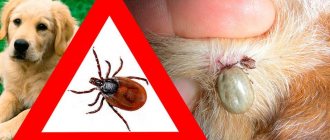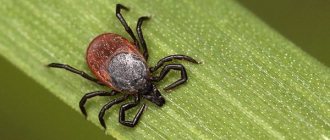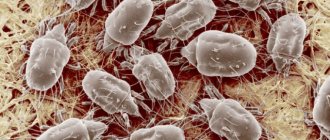The diversity of ticks is very large; they have colonized all continents and climatic zones. Different types of ticks lead different lifestyles. Among mites there are predators, saprophytes, plant pests, parasites of humans and animals.
People and animals are attacked by ticks belonging to the following families: Gamasoidea (gamasid ticks), Trombidiidae (red ticks), Argasidae (argas ticks), Ixodidae (ixodid ticks). The families Argasidae and Ixodidae are combined into the superfamily Ixodoidea. Most parasitic ticks effectively transmit pathogens of infectious diseases in humans and animals. The range of diseases transmitted depends on the area and type of tick. Different types of ticks have their own biological characteristics, which must be taken into account when developing protection tactics. There are highly specialized species of ticks that have switched to feeding on one type of animal. Some ticks never attack humans, others only when there is no main host, and for some types of ticks humans are the usual victim.
In Russia, ticks of the family Ixodidae are of greatest importance as carriers of infectious diseases.
The genus Ixodes includes the main carriers of tick-borne encephalitis and borreliosis - the taiga tick and the dog tick. (People call them encephalitis ticks). People in the temperate zone of Eurasia are most often bitten by these ticks. The taiga tick is common in Siberia, the dog tick in Europe. A typical biotope for ticks Ix. persulcatus is primarily found in moist, shaded forest areas. In the eastern regions of the European part of Russia, both types of ticks are found.I. persulcatus, whose distribution covers the territory from the Baltic States to the Far East
Representatives of the genus Hyalomma, living in the southern regions of Russia, are carriers of a dangerous disease - Crimean hemorrhagic fever. The most common is Hyalomma marginatum. This is a two-host tick - the development of the larva into a nymph and the nymph into an adult tick occurs on one host. An adult tick is looking for a new victim.
Species of ticks from the genus Dermacentor carry pathogens of tick-borne encephalitis, Omsk hemorrhagic fever, tularemia, tick-borne North Asian rickettsiosis (tick-borne North Asian typhus), Q-fever. They are also an important vector of canine piroplasmosis. The feeders of young forms of ticks of the genus Dermacentor are small rodents (mice, voles). Therefore, the number of these mites is directly related to the number of mouse-like rodents.
These mites are easily identified by the white pattern on their dorsal shield. They also differ in the way they eat. The tick makes several test punctures before it begins to suck blood.
A typical inhabitant of the zone of deciduous and mixed forests in Europe and Siberia. It is not found in tall forests devoid of herbaceous vegetation. Prefers open spaces - forest glades, forest edges, meadows, pastures, can tolerate flooding, lives in flooded meadows, can be found on lawns. In areas of livestock grazing, foci of mass reproduction of the Dermacentor reticulatus tick are created. It has high cold resistance. The activity of meadow ticks begins earlier than that of taiga ticks. When thawed patches appear, bites from Dermacentor reticulatus ticks are possible. The greatest activity of meadow ticks is in April - May. In autumn there is a second, smaller peak of activity. Meadow ticks stop activity completely when snow falls.
What is the danger?
The main harm from a tick is that it is a carrier of dangerous diseases. Infection occurs during the bite of a sick animal. The infection or virus develops inside the tick for about 5 days. Distributes throughout the body and persists throughout life. The female tick is capable of transmitting harmful microorganisms to the larvae. Every bite can be dangerous. Microorganisms are found in saliva and blood. Infection of a person can occur immediately after a tick bite, and as a result of its crushing. Or through food - raw milk. Different types of ixode ticks are considered carriers:
- Hemorrhagic fever;
- Relapsing tick-borne typhus;
- Tick-borne encephalitis;
- Tick-borne typhus;
- Ehrlichiosis;
- Tularemia;
- Lyme disease or borreliosis;
- Q fever.
A narrow list of diseases that ticks can transmit. But this does not mean that after each tick bite there will be a whole epidemic, an outbreak of a specific disease. For example, encephalitis can be transmitted by 1–20% of ticks of the ixode family. Some people develop antibodies to viruses or have a mild form of the disease. Severe cases lead to damage to the central nervous system, heart, and blood vessels. If left untreated or with the wrong medications, disability or death may occur. Vaccination against ixodes ticks is carried out. People of any age are susceptible to diseases. Children can become infected.
In addition, ixode ticks cause harm to livestock and pets. Some species constantly parasitize the body, others crawl only to feed on blood. Numerous skin lesions, scratches appear on the surface of the body, and a new infection is introduced. The harm increases tenfold.
Dermacentor marginatus
A tick parasitizes an animal. Belongs to pasture. Forest dwellers and livestock are susceptible to infection. It is considered a carrier of all diseases that are characteristic of ticks. It takes 1 year for the Dermacentor marginatus mite to fully develop. During this time, all stages pass through: egg, larva, nymph, adult or adult. The egg takes 2–10 weeks to develop. The larva and nymph develop for about a month. During this period, the harm from them is no less than from an adult tick. Imago 1.5 months. An adult lives for about 2 years. The female is larger than the male. Body length is about 5 mm. During feeding, the chitinous cover of the body expands, the mite increases in size to 15 mm. The adult female parasitizes and feeds, since the male dies soon after fertilization.
They prefer to feed on cattle. An adult Dermacentor marginatus is capable of parasitizing humans. The tick is found in European countries and on the islands of the Mediterranean Sea. This type of tick is found in steppes and mountains. When heavily infested, it is found in forests. The harm caused by ticks is the spread of dangerous diseases. The bite itself is not particularly dangerous. But with severe infection or attack on young animals, growth begins to slow down and death may occur. This type of tick does not stop its activity in winter. The female is especially active. In addition, in winter they are more active than at other times of the year. The harm is manifested by numerous skin lesions.
Insecticidal preparations and vaccination are used as protection against ticks. Simple methods can prevent significant harm to the body.
Dermacentor marginatus (grazing mite)
found in the steppes and forest-steppes of the European part of Russia, Transcaucasia, Kazakhstan, in the mountains of Central Asia, in the south of Western Siberia, in flat and mountain steppes, in forest-steppes, in mountain forests (on pastures), ravines, floodplain meadows, forest belts.
The danger of catching these bloodsuckers is most likely in the spring, especially in rainy weather. Bloodsuckers can wait for animals anywhere: in the forest, in the country. The ticks themselves are not dangerous; after drinking blood, they leave the animals themselves, but the injuries they inflict injure the skin, leading to various swelling and inflammation. But the most dangerous thing is that toxic substances and pathogens of infectious diseases can enter the animal’s body along with the tick’s saliva. For cats and dogs, ticks are dangerous as carriers of piroplasmosis.
Dermacentor reticulatus
Meadow tick. Also called pasture. The Dermacentor insect species differs from other mites in its bright marbled color. Found in forest-steppes, steppes of Europe and Siberia. Very rarely does the Dermacentor species end up in the mountains. A representative of deciduous forests, a carrier of dangerous diseases. Previously, Dermacentor reticulatus lived in cloudy forests and swamps. Today, reticulatus parasitizes city parks and alleys. The victims choose cattle, wild animals and domestic dogs. The harm caused by the reticulatus mite is the spread of dangerous diseases. This species of tick is primarily a carrier of babesiosis. The disease manifests itself almost immediately after the bite. Dermacentor reticulatus is characterized by great resistance to cold. High activity is observed in the spring and stops with snowfall. During the period of livestock grazing, entire foci of infection with reticulatus ticks are created. The female lays eggs at the speed of light. To do this, she needs to constantly eat.
The female of the species Dermacentor reticulatus is capable of reproducing mite offspring throughout her life after one fertilization. Each bite of a Dermacentor tick becomes a trigger for the onset of a new stage of development. From the formation of an egg to the formation of an adult. Species of ticks that belong to the genus Dermacentor can often feed on mice and rats. These animals act as food for many others and spread pathogens. The range of carriers is expanding. The reticulatus species loves open space; to pick up a Dermacentor tick, it is not necessary to visit the forest. The Dermacentor mite is a serious health hazard. The female is able to feed once every 5 days. An individual that develops does this more often.
Life cycle of a bloodsucker
The life cycle of the meadow tick consists of four stages: eggs, larvae, nymphs and adults. The development of the tick lasts for one year; adult individuals go into winter diapause.
Scheme of the life cycle of the meadow tick.
On a note
Diapauses are inactive periods in the life of arachnids. During this time, they stop hunting and feeding, and all their metabolic processes slow down. This condition helps the bloodsucker survive uncomfortable climatic conditions.
Like most ixodids, the meadow tick is three-host, that is, at each active stage of its development it hunts a new victim, after which it molts and transforms into the next stage. And at the imago stage, after saturation, the female forms a clutch of eggs.
Normal saturation is possible only in inseminated females. Unfertilized females can remain on the host's body for up to a month, but do not reach a state of satiety. Mating occurs either in hungry individuals in the natural environment, or directly while the female is feeding.
A feeding unfertilized female secretes volatile pheromones with special glands that begin to work after a few days of feeding. The males catch the smell of these secretions with Haller's organs and, having detached themselves, crawl towards the female. Uninseminated females die undernourished on the host's body or after its abandonment.
It is also useful to read: Ixodid ticks
The fertilized female lays eggs 1-25 days after feeding, the larvae hatch on the 44-80th day. The timing of the formation of eggs and the appearance of offspring depends on the ambient temperature. For several days after hatching, the larvae are inactive and do not react to the approach of potential victims.
Larvae and nymphs of meadow ticks feed mainly on small rodents - mice and voles, therefore the size of the parasite population is closely related to the number of these rodents.
Nymph of meadow tick.
The main prey of adults are ungulates. The bloodsucker lies in wait for them in meadows and pastures, but can also attack humans, although he is not the main feeder of this arachnid.
This is interesting
Ixodids are able to adapt well to environmental conditions. Their attachment to host animals is not strict, and the choice of the main victims is related to the habitat and what animals are most often found there. Therefore, the same type of tick can successfully attack ungulates, predators, and humans.
An adult meadow tick can live hungry for more than two years. Adults of the genus Dermacentor in temperate climates have the longest life expectancy among all ixodids.
Haemaphysali
Ticks of this species love warmth and moisture. The individual is found mainly in forests. Haemaphysali especially love birch groves, aspen alleys and mixed coniferous forests. Distributed everywhere. Within a month, a female Haemaphysali mite is capable of laying about 1 thousand eggs. Adults of this species prefer to feed on large horned animals. Tick larvae and nymphs drink the blood of rats, mice, dogs, hares and other forest inhabitants. The female gives birth to 1 thousand larvae. They begin to feed immediately after birth.
Haemaphysali live for about 2 years. During this time, the carrier of diseases is capable of infecting both people and animals. Individual ticks can feed on both.
Rhipicephalus sanguineu
It is popularly called the brown dog tick. Distributed throughout our country. Rhipicephalus sanguineu is capable of parasitizing dogs. Less commonly, individuals move to feed on cats, rodents, and other small animals. This is mainly done by a female and a male individual who has not yet entered into sexual contact. Because after the act, the male dies.
This species of tick is capable of overwintering at different stages of development. They are mainly found in places where dogs are often found - kennels, bedding, soil, grass. Mating takes place directly on the animal. This is where the tick Rhipicephalus sanguineu spends most of its life. The female also lays eggs on the surface of the animal. The entire developmental life cycle of Rhipicephalus sanguineu is about 2–3 months. Ticks of the Rhipicephalus species are very sensitive to temperature changes. When unfavorable conditions occur, development slows down or stops altogether. With the onset of warmth, individuals begin to actively feed, and growth is restored. Rhipicephalus cause harm to animals through bites that constantly itch, cause discomfort, and irritation. And, of course, a tick bite can cause a dangerous disease. Insecticides are used to prevent ticks.
Features of lying in wait and attacking the victim
Finding a host is a very important stage in the life of ticks. They use their prey for maximum saturation, increasing their mass by drinking blood a hundred times.
Blood-sucking arachnids passively lie in wait for their victims. To do this, the parasite needs to find a place that meets the following parameters:
- Optimal temperature;
- Sufficient humidity;
- Availability of production.
The meadow tick prefers wet grass fields and bushes. The parasite is located on the grass at a height of several centimeters to a meter. Most often it climbs onto dried cereal straws.
The tick rests on a blade of grass with its forelimbs extended forward. When he senses the approach of a person or animal, he begins to make oscillatory movements with his paws in order to better perceive the smell. In this case, the parasite turns towards the prey, waiting for physical contact, in order to crawl onto it.
The meadow tick is ready to attack.
On a note
The tick needs contact with the victim; it cannot jump or fall on it.
If the victim does not approach, but its presence continues to be felt nearby (up to 10 meters), the parasite can descend from its post and crawl to it. The speed of movement of the meadow tick on a horizontal surface is about 40 cm per minute.
It is also useful to read: Ear mites in dogs and their danger to pets
Once on the host, the parasite moves around its body for some time in search of a place to attach. The tick prefers to attach itself where it will be more difficult for the victim to get the bloodsucker, and where it is easier for the tick itself to cut through the skin and get to the blood vessels.
In most cases, the hosts of the meadow tick are ungulates. It is most often attached to their head or neck. Other favorite attachment sites for the parasite include the groin area, armpits, ears and the area behind them. A peculiarity of this type of tick is that the parasite, before starting to suck blood, makes several test punctures of the skin.
The arachnid cuts the skin with chelicerae, plunging them deeper into the wound. At the same time, the hypostome is inserted into the hole, and the palps are bent to the sides.
The oral apparatus of a tick under a microscope.
From the very beginning of the immersion of the oral apparatus into the skin of the victim, the parasite begins to actively secrete saliva. It has an analgesic effect and suppresses the host’s immune response, so the bite goes unnoticed. In addition, after some time the saliva hardens, forming a strong cement sheath around the hypostome.
Ticks of the genus Dermacentor are characterized by a short proboscis, most of which remains above the host's skin, while the parasite is firmly attached to the site of the bite with a case of congealed saliva. Its base is much wider than the wound incision due to deposits in the victim’s skin tissue.
An adult male tick needs only an hour to satiate, but a female can feed for 9-15 days. The mass of the parasite increases by 50-100 times. The feeding process occurs unevenly. During the first 6-36 hours after the start of feeding, the mass of the tick does not change - the arachnid simply replenishes water losses. On the 2-7th day of feeding, its mass increases 10-20 times. Its greatest growth occurs in the third stage - a day before falling away.
When the female has fallen away, she needs to find a secluded and moist place to form a clutch of eggs, the number of which ranges from 3 to 6 thousand. After this she dies.
Hyalomma
This type of tick is found in steppes and deserts around the globe. Certain species of Hyalomma mites are capable of settling in enclosed spaces. Individuals are found in barns, stalls and similar places where cattle are located. The entire development cycle takes 1 year. The adult Hyalomma tick prefers to feed on large animals. Larvae and nymphs choose rodents, dogs, rabbits, and small forest dwellers for this purpose. Hyalomma ticks are considered harmful bloodsuckers. Ticks reproduce at high speed and spend almost all their time on the victim. They chase the animal until a convenient opportunity arises to get over it. Ticks of the Hyalomma species are guided by their sense of smell. Their bite causes severe skin irritation and itching. The damage caused by the tick consists of damage to the skin. In addition, Hyalomma is a carrier of all diseases that are characteristic of ticks. Insecticides act as preventative agents.
Persulcatus
Taiga or European tick. Representatives of this species are the main carrier of tick-borne encephalitis. Ticks are more common in forests. But they are able to live on pastures and feed on blood. Persulcatus chooses animals as victims, but can also attack people. The female becomes infected herself and transmits microorganisms to her offspring. The virus or bacteria can remain in the tick's body for its entire life. In this case, the individual itself does not suffer. The development of the offspring of the Persulcatus species takes about 3 months. An adult can feed once every 10 days. Larvae and nymphs are able to feed more often. Moreover, the harm from them will be even greater than from an adult tick.
Dermacentor mites: types and their appearance
Winter tick
The winter tick has a red-brown color.
A well-fed individual reaches 1.5 cm in length, and a hungry one reaches 0.5 cm. This species lives in North America and is a parasite of American moose. Reference. 75,000 ticks were found on one elk.
Such an amount can lead to the death of the animal due to enormous blood loss. The winter tick lives for 1 year and only on one host . At the end of summer, the parasite emerges from the egg and climbs onto the grass about 1.25 cm high, after which it clings to a passing animal. On the host, the larva passes through the nymph stage and turns into an adult. At the end of winter, both males and females fall to the ground, where they lay eggs and die.
Rocky Mountain wood mite
The wood mite lives in the northwestern United States and southwestern Canada along the Rocky Mountains. This species grows up to 2-5 mm in length, and a well-fed female - up to 1.5 cm. The parasites are brown or red-brown in color. Sexual dimorphism is very pronounced - females have a silvery pattern on the upper side of the abdomen, which turns gray when she drinks blood, while males have gray or white spots that do not form a pattern. Also, females are quite often larger than males.
The life cycle of arthropods takes 1-3 years depending on natural factors and has 4 stages of development. The bloodsucker can have three hosts.
The emerging larva finds the first victim and, having drunk blood, falls off and molts into the nymph on the ground. The nymph repeats the same actions and turns into an adult.
Important! Larvae and nymphs do not attack people, while adults can also feast on humans.
American Canine/Arboreal
The American dog tick is quite colorful. The female has a light chest and a red-brown body, while the male has a white pattern on the chest, so large that it covers almost the entire dark brown background.
This species is found in the USA and Canada and is three-host . The life cycle length varies depending on weather conditions. These arthropods are the main carriers of diseases, and become them in adulthood. But the female lays uninfected larvae. After hatching from the egg, the larva settles on small mammals and can become infected with the virus. The nymph feeds in the same way as the larva, but adults prefer larger animals.
Attention! The American dog tick can also feed on humans. But he infects him only after 2 hours. If you notice the parasite during this time, you can avoid the disease.
African elephant
The African elephant tick lives in Africa. Hungry parasites reach 3-5 mm in length. These arthropods are brown in color with a yellow tint. Females have 3 spots on the scute (1 at the back and 1 on each side closer to the head), and males have 8 spots on the border of the dorsal scute.
This species was found only on elephants and gray duiker .
Reference. The main hosts of these tough ticks are the African bush elephant and the African forest elephant. They show no interest in people.
Indian dermacentor
This species inhabits India, Sri Lanka, Indonesia, Vietnam and Thailand. The body length of a hungry tick is 7 mm, width is 5 mm. Adults have a large number of patterns on the body, chest and legs.
Attention! This species is the most dangerous for humans!
Adults are potential carriers of rickettsia, gram-negative bacteria, protozoan blood parasites and Lanyang virus. They parasitize mammals (deer, humans, wild pigs) and pythons .
Meadow tick
The meadow mite, or dermacentor reticulatus, lives in Europe and Western Asia. It can be found on lawns, forest edges, clearings, pastures and meadows. Feels great in open spaces and tolerates flooding well.
Reference. There are quite a lot of ticks of this species in Russian forests. Especially in Siberia.
The female is smaller than the male - her body size in the hungry state is 3.8-4.2 mm, and the male is 4.4-4.8 mm. But, after the female drinks blood, it can increase to 10 mm. This species has a dark brown color. The male's back is richly decorated with a light pattern, and it is often difficult to see the main background under the pattern.
It is a three-host parasite, making it quite dangerous to humans . The female drinks blood for 9-15 days, after which she falls to the ground and lays 3000-4500 eggs. The larvae hatch after 2-3 weeks and immediately begin hunting for the host.
Attention! There is no difference between the dog tick and the meadow tick, as there is between disease carriers.
Pasture mite
The pasture tick occupies alpine forests, semi-desert areas and forest-steppes of Western Asia and Europe. It overlaps with the meadow tick at the border of its ranges - meadow ticks prefer wet places, and pasture ticks prefer dry steppe areas.
This species is very similar to meadow ticks , and a non-specialist can easily confuse them.
These arthropods can change three hosts . Larvae parasitize small mammals, nymphs can attack hedgehogs, foxes and wolves, and adults parasitize mainly domestic animals (sheep, goats, cows, dogs, horses) and some wild animals. Their life cycle is 1-2 years, depending on how quickly an adult finds a host.
Important! This arthropod prefers to parasitize sheep, which is why it is also called the “sheep tick,” but sometimes it attacks people.











